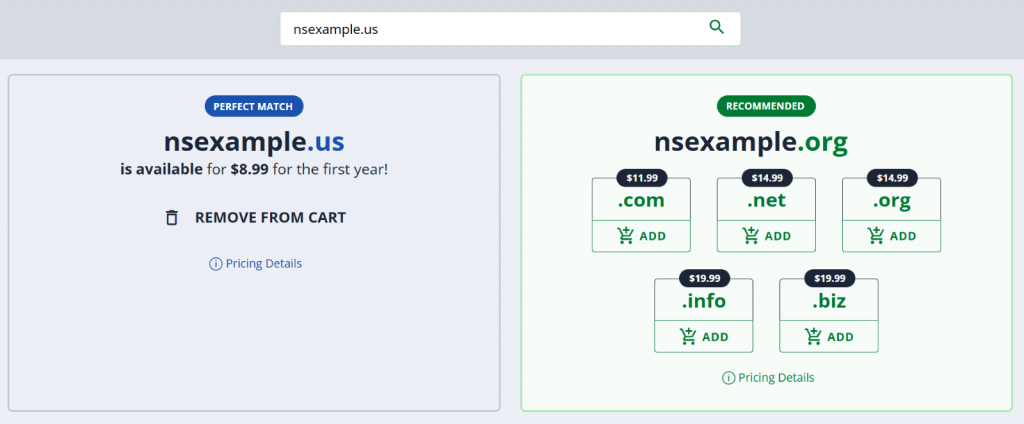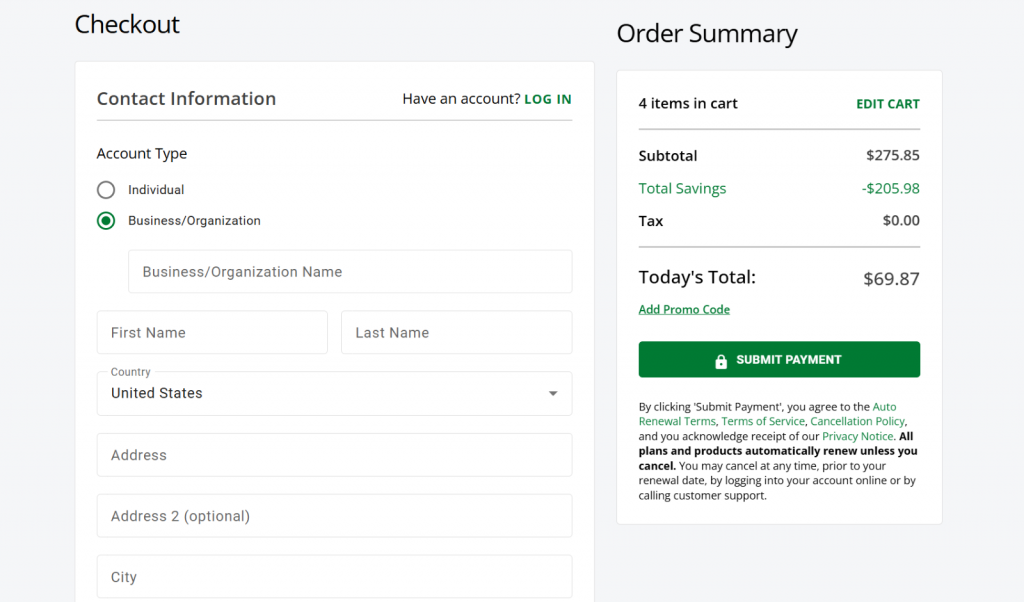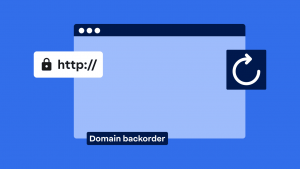Key takeaways:
- ccTLDs are strong online geo-signals that boost websites in country-specific search results.
- ccTLDs connect and project credibility to local users, giving a sense of familiarity.
- To choose the right ccTLD, consider your target audience, language relevance, and other key factors.
If you want your business to appear more online, especially locally, you need a website. But more than just a website, you also need a catchy, solid domain name. This is where country code top-level domains (ccTLDs) come into play, connecting you to your target local audience.
More than just a two-letter extension, a ccTLD is a part of your website that impacts your online local visibility and search engine optimization (SEO) efforts. We’ll break down how they work in this blog, including their benefits and how to pick the right one for your business.

What is a ccTLD?
A ccTLD, or country code top-level domain, is a two-letter domain extension assigned to a particular country (e.g., .uk for the United Kingdom). They help indicate a website’s country of origin; a generic top-level domain (gTLD) like .com doesn’t do that. For instance, while a .com domain might suggest a commercial and global brand, a .ca domain tells visitors that the website is intended for a Canadian audience.
However, there’s an exception to the two-letter rule: internationalized domain ccTLDs (IDN ccTLDs) that allow non-Latin characters in the ccTLD itself. For example, Sri Lanka offers both .lk and scripts in Sinhalese/Tamil (e.g., .ලංකා, .இலங்கை).
History and governance of ccTLDs
ccTLDs trace their origins back to the ISO 3166-1 country code list, which assigns unique two-letter codes to every recognized country or territory. In the mid-1980s, these codes were adapted for the Internet’s naming system, and some of the earliest ccTLDs were delegated. More than 300 ccTLDs have been created since then, including some regions and overseas territories.
ccTLDs are managed and coordinated by the Internet Assigned Numbers Authority (IANA), under the oversight of the Internet Corporation for Assigned Names and Numbers (ICANN). While IANA delegates each ccTLD, designated national registries or authorities (Network Information Centers or NICs) are responsible for the day-to-day operation and policymaking of the domain extensions.
For example, Nominet acts as the registry for .uk, while DENIC serves Germany’s .de; many countries even use the NIC naming convention for their registry websites (e.g., nic.fr) for easier identification. Their rules can vary widely: some allow worldwide adoption (e.g., .io or .me), while others require a local presence or citizenship.
Why do websites use ccTLDs?
Websites use ccTLDs for several important reasons, such as the following:
- To target local users. A ccTLD communicates relevance to specific regions and facilitates specific content, mostly by language, to countries.
- To build regional trust and credibility. Using a ccTLD helps you connect and establish trust with local users. It shows a commitment to the local market and a better understanding of the local nuances.
- To comply with country-specific regulations. ccTLDs can help comply with specific online regulations (e.g., data privacy or language requirements) in certain regions.
They’re powerful tools for building trust and local relevance; choosing the right ccTLD can strengthen your digital presence towards your target audience.
Advantages of ccTLDs
ccTLDs mainly help with localization, but they also have more benefits for your online branding goals, including the following:
- Builds trust and relevance
- Complies with legal and regulatory requirements
- Offers branding opportunities
- Enhances local SEO and visibility
Let’s look at each of these advantages in more detail:
Builds trust and relevance
A ccTLD shows your site’s focus on a specific region, helping you connect more with your local audience. For example, a .ca extension is more relatable to Canadian users than a gTLD.
Complies with legal and regulatory requirements
In certain situations, you might need a ccTLD for a region’s specific regulations. For instance, the European Union has data protection laws like the General Data Protection Regulation (GDPR), which require websites to use a .eu TLD when collecting personal data from EU users.
Similarly, some countries may require businesses to use certain ccTLDs within their region, particularly in finance or healthcare. For instance, UK banks might mandate .uk TLDs for customer interactions.
Offers branding opportunities
You can also creatively use ccTLDs for branding purposes, such as in the .tv domain case. It’s originally assigned to the island nation of Tuvalu, but it has become popular for media-related websites. Similarly, the .me domain, assigned to Montenegro, is often used for personal websites and blogs.
Enhances local SEO and visibility
Google and other search engines prioritize relevance to the user’s search intent. A ccTLD doesn’t automatically prioritize your website and boost it to the top of the local search rankings since domains aren’t a direct ranking factor. However, it does help Google recognize that your content is relevant to a specific location and audience.
An online clothing store with a .nz domain is more likely to appear in New Zealand than in the US since users and Google can see the website is catered to Kiwis. But that doesn’t stop a big shopping site with a .com domain from appearing as well if it has great content quality, authoritative backlinks, and good site performance.
You need to combine your ccTLD with strong SEO practices to compete with global websites. If both you and your competition managed to do equal optimization, having a ccTLD primarily puts you on an advantage in the local market.

List of available ccTLDs
Below is a comprehensive list of currently delegated ccTLDs. Use it as a reference to explore each domain extension; note that registration rules and availability can vary for every registry.
| ccTLD | Country or Territory | Delegation status | Notes |
|---|---|---|---|
| .ad | Andorra | Active | |
| .ae | United Arab Emirates | Active | |
| .af | Afghanistan | Active | |
| .ag | Antigua and Barbuda | Active | |
| .ai | Anguilla | Active | |
| .al | Albania | Active | |
| .am | Armenia | Active | |
| .ao | Angola | Active | |
| .aq | Antarctica | Active | Restricted; limited eligibility |
| .ar | Argentina | Active | |
| .as | American Samoa | Active | |
| .at | Austria | Active | |
| .au | Australia | Active | |
| .aw | Aruba | Active | |
| .ax | Ã…land Islands | Active | |
| .az | Azerbaijan | Active | |
| .ba | Bosnia and Herzegovina | Active | |
| .bb | Barbados | Active | |
| .bd | Bangladesh | Active | |
| .be | Belgium | Active | |
| .bf | Burkina Faso | Active | |
| .bg | Bulgaria | Active | |
| .bh | Bahrain | Active | |
| .bi | Burundi | Active | |
| .bj | Benin | Active | |
| .bm | Bermuda | Active | |
| .bn | Brunei Darussalam | Active | |
| .bo | Bolivia | Active | |
| .br | Brazil | Active | |
| .bs | Bahamas | Active | |
| .bt | Bhutan | Active | |
| .bv | Bouvet Island | Inactive/Reserved | Not in active use |
| .bw | Botswana | Active | |
| .by | Belarus | Active | |
| .bz | Belize | Active | |
| .ca | Canada | Active | |
| .cc | Cocos (Keeling) Islands | Active | |
| .cd | Congo, Democratic Republic of the | Active | |
| .cf | Central African Republic | Active | |
| .cg | Congo | Active | |
| .ch | Switzerland | Active | |
| .ci | Côte d’Ivoire | Active | |
| .ck | Cook Islands | Active | |
| .cl | Chile | Active | |
| .cm | Cameroon | Active | |
| .cn | China | Active | |
| .co | Colombia | Active | |
| .cr | Costa Rica | Active | |
| .cu | Cuba | Active | |
| .cv | Cabo Verde | Active | |
| .cw | Curaçao | Active | |
| .cx | Christmas Island | Active | |
| .cy | Cyprus | Active | |
| .cz | Czechia | Active | |
| .de | Germany | Active | |
| .dj | Djibouti | Active | |
| .dk | Denmark | Active | |
| .dm | Dominica | Active | |
| .do | Dominican Republic | Active | |
| .dz | Algeria | Active | |
| .ec | Ecuador | Active | |
| .ee | Estonia | Active | |
| .eg | Egypt | Active | |
| .eh | Western Sahara | Inactive/Not Delegated | No operational registry |
| .er | Eritrea | Active | |
| .es | Spain | Active | |
| .et | Ethiopia | Active | |
| .eu | European Union | Active | Special regional ccTLD |
| .fi | Finland | Active | |
| .fj | Fiji | Active | |
| .fk | Falkland Islands | Active | |
| .fm | Micronesia, Federated States of | Active | |
| .fo | Faroe Islands | Active | |
| .fr | France | Active | |
| .ga | Gabon | Active | |
| .gb | United Kingdom (GB) | Inactive/Reserved | Superseded by .uk; not used |
| .gd | Grenada | Active | |
| .ge | Georgia | Active | |
| .gf | French Guiana | Active | |
| .gg | Guernsey | Active | |
| .gh | Ghana | Active | |
| .gi | Gibraltar | Active | |
| .gl | Greenland | Active | |
| .gm | Gambia | Active | |
| .gn | Guinea | Active | |
| .gp | Guadeloupe | Active | Includes Saint- Barthélemy and Saint-Martin historically |
| .gq | Equatorial Guinea | Active | |
| .gr | Greece | Active | |
| .gs | South Georgia and the South Sandwich Islands | Active | |
| .gt | Guatemala | Active | |
| .gu | Guam | Active | |
| .gw | Guinea-Bissau | Active | |
| .gy | Guyana | Active | |
| .hk | Hong Kong | Active | |
| .hm | Heard Island and McDonald Islands | Active | Uninhabited; registry open to public |
| .hn | Honduras | Active | |
| .hr | Croatia | Active | |
| .ht | Haiti | Active | |
| .hu | Hungary | Active | |
| .id | Indonesia | Active | |
| .ie | Ireland | Active | |
| .il | Israel | Active | |
| .im | Isle of Man | Active | |
| .in | India | Active | |
| .io | British Indian Ocean Territory | Active | |
| .iq | Iraq | Active | |
| .ir | Iran, Islamic Republic of | Active | |
| .is | Iceland | Active | |
| .it | Italy | Active | |
| .je | Jersey | Active | |
| .jm | Jamaica | Active | |
| .jo | Jordan | Active | |
| .jp | Japan | Active | |
| .ke | Kenya | Active | |
| .kg | Kyrgyzstan | Active | |
| .kh | Cambodia | Active | |
| .ki | Kiribati | Active | |
| .km | Comoros | Active | |
| .kn | Saint Kitts and Nevis | Active | |
| .kp | Korea, Democratic People’s Republic of (North Korea) | Active | |
| .kr | Korea, Republic of (South Korea) | Active | |
| .kw | Kuwait | Active | |
| .ky | Cayman Islands | Active | |
| .kz | Kazakhstan | Active | |
| .la | Lao People’s Democratic Republic | Active | |
| .lb | Lebanon | Active | |
| .lc | Saint Lucia | Active | |
| .li | Liechtenstein | Active | |
| .lk | Sri Lanka | Active | |
| .lr | Liberia | Active | |
| .ls | Lesotho | Active | |
| .lt | Lithuania | Active | |
| .lu | Luxembourg | Active | |
| .lv | Latvia | Active | |
| .ly | Libya | Active | |
| .ma | Morocco | Active | |
| .mc | Monaco | Active | |
| .md | Moldova, Republic of | Active | |
| .me | Montenegro | Active | |
| .mf | Saint Martin (French part) | Inactive/Reserved | Not operational in root |
| .mg | Madagascar | Active | |
| .mh | Marshall Islands | Active | |
| .mk | North Macedonia | Active | |
| .ml | Mali | Active | |
| .mm | Myanmar | Active | |
| .mn | Mongolia | Active | |
| .mo | Macao | Active | |
| .mp | Northern Mariana Islands | Active | |
| .mq | Martinique | Active | |
| .mr | Mauritania | Active | |
| .ms | Montserrat | Active | |
| .mt | Malta | Active | |
| .mu | Mauritius | Active | |
| .mv | Maldives | Active | |
| .mw | Malawi | Active | |
| .mx | Mexico | Active | |
| .my | Malaysia | Active | |
| .mz | Mozambique | Active | |
| .na | Namibia | Active | |
| .nc | New Caledonia | Active | |
| .ne | Niger | Active | |
| .nf | Norfolk Island | Active | |
| .ng | Nigeria | Active | |
| .ni | Nicaragua | Active | |
| .nl | Netherlands | Active | |
| .no | Norway | Active | |
| .np | Nepal | Active | |
| .nr | Nauru | Active | |
| .nu | Niue | Active | |
| .nz | New Zealand | Active | |
| .om | Oman | Active | |
| .pa | Panama | Active | |
| .pe | Peru | Active | |
| .pf | French Polynesia | Active | |
| .pg | Papua New Guinea | Active | |
| .ph | Philippines | Active | |
| .pk | Pakistan | Active | |
| .pl | Poland | Active | |
| .pm | Saint Pierre and Miquelon | Active | |
| .pn | Pitcairn | Active | |
| .pr | Puerto Rico | Active | |
| .ps | Palestine, State of | Active | |
| .pt | Portugal | Active | |
| .pw | Palau | Active | |
| .py | Paraguay | Active | |
| .qa | Qatar | Active | |
| .re | Réunion | Active | |
| .ro | Romania | Active | |
| .rs | Serbia | Active | |
| .ru | Russian Federation | Active | |
| .rw | Rwanda | Active | |
| .sa | Saudi Arabia | Active | |
| .sb | Solomon Islands | Active | |
| .sc | Seychelles | Active | |
| .sd | Sudan | Active | |
| .se | Sweden | Active | |
| .sg | Singapore | Active | |
| .sh | Saint Helena, Ascension, and Tristan da Cunha | Active | |
| .si | Slovenia | Active | |
| .sj | Svalbard and Jan Mayen | Inactive/Reserved | Not in active use |
| .sk | Slovakia | Active | |
| .sl | Sierra Leone | Active | |
| .sm | San Marino | Active | |
| .sn | Senegal | Active | |
| .so | Somalia | Active | |
| .sr | Suriname | Active | |
| .ss | South Sudan | Active | |
| .st | Sao Tome and Principe | Active | |
| .su | Soviet Union | Active/Legacy | Legacy code still in use |
| .sv | El Salvador | Active | |
| .sx | Sint Maarten (Dutch part) | Active | |
| .sy | Syrian Arab Republic | Active | |
| .sz | Eswatini (Swaziland) | Active | |
| .tc | Turks and Caicos Islands | Active | |
| .td | Chad | Active | |
| .tf | French Southern Territories | Active | |
| .tg | Togo | Active | |
| .th | Thailand | Active | |
| .tj | Tajikistan | Active | |
| .tk | Tokelau | Active | |
| .tl | Timor-Leste | Active | |
| .tm | Turkmenistan | Active | |
| .tn | Tunisia | Active | |
| .to | Tonga | Active | |
| .tr | Türkiye | Active | |
| .tt | Trinidad and Tobago | Active | |
| .tv | Tuvalu | Active | |
| .tw | Taiwan, Province of China | Active | |
| .tz | Tanzania, United Republic of | Active | |
| .ua | Ukraine | Active | |
| .ug | Uganda | Active | |
| .uk | United Kingdom | Active | |
| .us | United States of America | Active | |
| .uy | Uruguay | Active | |
| .uz | Uzbekistan | Active | |
| .va | Holy See (Vatican City State) | Active | |
| .vc | Saint Vincent and the Grenadines | Active | |
| .ve | Venezuela (Bolivarian Republic of) | Active | |
| .vg | Virgin Islands (British) | Active | |
| .vi | Virgin Islands (U.S.) | Active | |
| .vn | Viet Nam | Active | |
| .vu | Vanuatu | Active | |
| .wf | Wallis and Futuna | Active | |
| .ws | Samoa | Active | |
| .ye | Yemen | Active | |
| .yt | Mayotte | Active | |
| .za | South Africa | Active | |
| .zm | Zambia | Active | |
| .zw | Zimbabwe | Active |
How do you register a ccTLD?
If you already complied with your ccTLD’s requirements, it’s now easier to register one for your business. Follow these steps, so you can use local domain extensions afterwards.
- Check availability. Visit your domain registrar’s website and use their domain search tool. Enter your desired domain name followed by the specific ccTLD extension you want.

- Select your domain and add it to your cart. Once you’ve found an available ccTLD to your liking, select it and add it to your cart. You’ll have options for registration periods (e.g., 1 year, 2 years, up to 10 years).

- Complete your registration details. Proceed to checkout; you’ll be prompted to provide your contact and billing information.

- Finalize your purchase. Review your order and complete the payment. Network Solutions will then process your registration, and your new ccTLD will be fully active within a few hours.

How do you choose the right ccTLD?
Selecting the appropriate ccTLD calls for careful, deliberate consideration. Consider the following key factors when choosing ccTLDs:
- Target audience alignment. Determine whether the country domain matches your primary market. If your business focuses on Canadian customers, a .ca domain is a logical choice.
- Language relevance. While some ccTLDs are used globally (.io, .ai), ensure the language aligns for country-specific targeting.
- Registration requirements and restrictions. Some ccTLDs require local presence or specific legal entities to register.
- Availability of the desired domain name. Just like gTLDs, check if your desired domain name is up grabs under the chosen ccTLD. If not, consider variations if your first choice is taken.
- Cost and renewal fees. While some ccTLDs are inexpensive, others can be significantly more costly.
- Long-term business strategy. If you anticipate expanding into other countries, secure their respective ccTLDs early on for brand protection and future growth.
Always go over these factors when choosing ccTLDs; the right one will balance market reach and long-term growth for your brand.
Technical considerations for choosing a ccTLD
Before registering a ccTLD, check the following technical details, which may vary by country:
- Eligibility requirements. Some ccTLDs have strict requirements, such as local presence or citizenship. For example, registering a .us domain requires a physical presence in the United States.
- Registration costs and renewal. ccTLD registration and renewal costs can vary significantly depending on the extension, ranging from free to over $200 yearly.
- Hosting and infrastructure. Some ccTLDs may require your website to be hosted on servers in the corresponding country; this can affect hosting provider choices and website maintenance costs.
- Privacy restrictions. Many ccTLDs restrict Domain Privacy, which exposes your registrant data in public WHOIS databases. Always review the registry’s privacy practices to see if domain privacy is allowed.
Always consider these details so that your ccTLD aligns with your brand strategy and works seamlessly from a technical standpoint.
Real-world examples of successful ccTLD usage
Numerous businesses effectively use ccTLDs to achieve their local and international targeting goals. Here are some examples of successful ccTLD usage by businesses:
- Amazon. Amazon uses a vast network of ccTLDs to serve customers worldwide. For example, Amazon.co.uk is for the United Kingdom, Amazon.de is for Germany, Amazon.fr is for France, and Amazon.co.jp is for Japan.
- BBC. The British Broadcasting Corporation utilizes bbc.co.uk as its primary domain for its UK audience, showing its national origin and targeting. This allows them to deliver news and content specifically relevant to the UK, while still having international reach.
- Many national banks or government websites. These entities use their respective ccTLDs almost universally (e.g., Bank of America uses .us for the US bank and local extensions for specific international branches).
Frequently asked questions
It depends on the specific ccTLD. Some ccTLDs have restrictions, while others do not.
ccTLDs can enhance trust by showing focus on a specific region. However, trust also has a lot to do with the website’s content and reputation, among many other factors.
If you plan to expand globally, consider using a gTLD like .com and your ccTLD. Using both domains helps you reach a broader audience while maintaining your local presence.
The main possible “disadvantage” can be registration restrictions for certain ccTLDs, which might require a local presence or specific legal entities.
The .to domain is the country code top-level domain (ccTLD) for Tonga, a nation in the South Pacific. It’s also popular worldwide because it works well in short links and domain hacks (like “go.to”).
A top-level domain country code, or ccTLD, is a two-letter domain extension assigned to a country or territory. For example, .de represents Germany, .ca represents Canada, and .uk represents the United Kingdom.
.io is officially the ccTLD for the British Indian Ocean Territory. However, it’s widely adopted by startups and tech companies because “IO” is commonly associated with computing terms like “input/output.”

Grow your local reach with ccTLDs from Network Solutions
By choosing the right domain name, you can significantly boost your online presence. Whether targeting a local or global audience, Network Solutions offers various domain options to meet your needs. Our Domain Name Search tool helps you find and register the perfect ccTLD.
Explore your options and find the ideal ccTLD for your website with Network Solutions!





